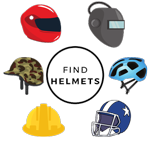How Do Helmets Prevent Concussions
It’s critical to comprehend how head impacts might cause injuries before discussing how helmets function and what they can do. The brain, which has the consistency of soft tofu, can move back and forwards (translational movements) or rotate and twist on itself in response to a blow to the head (rotational movements).
Describe Concussion
The cerebrospinal fluid surrounding the brain acts as a cushion to keep it safe while it floats inside the skull. A direct blow to the head, face, or neck or an impact on another part of the body may shake the brain. The brain can move to strike the skull or turn in on itself when that force is powerful enough or originates from a specific direction.
Bruising and cell damage are possible, just like with any body part that has been struck. But if those cells are neurons, the result is a concussion. The symptoms of a concussion can be widespread since the brain plays such a significant role in our life, directing our emotions, perceptions, and movements.
How A Concussion Damages The Brain
The most prevalent and mild type of traumatic brain damage is a concussion. The brain floats within the skull in a cushioned suspension of cerebrospinal fluid. Trauma happens when the brain moves inside the head and collides with the skull due to a direct contact or whiplash action, either from a blow to the head or body.
As a result, concussion harms the neurons, and the impact site on the brain may bleed. Trauma can happen without loss of consciousness. It only takes a modest amount of force to cause one.
According to experts, 42 million people sustain concussions each year. Slips, trips, or falls cause the concussion in most cases. Moreover, people often don’t seek medical care, which worsens the conditions.
Concussions are challenging to treat because they frequently occur without symptoms like disorientation or lack of coordination. Structural imaging techniques like CT or MRI only detect more considerable brain bleeding. The diagnosis often hinges on the patient’s self-report of symptoms. Confusion, memory loss, and headache are the most common symptoms. However, they may not be immediately noticeable.
You can also read about: Useful Guide To Buy New Dirt Bike Helmets
Who Is The Most Susceptible To Concussions?
According to experts, Concussions and contact sports have linked together. Concussions are, nonetheless, prevalent in the general population. It can be sustained by various other activities and frequently brought on by a fall or car accident.
A hit to the head might have severe or modest effects. While concussions are typically the result of being “knocked out,” it is possible to have a concussion without being unconscious. In most situations, athletes who get concussions while playing sports are still awake, and the problem frequently goes untreated. Additionally, even while protective headgear shields the skull from bruising during blows with high impact, the brain can still move about inside the head.
Rugby players and boxers, for example, are at an increased risk of concussion compared to the general population. Military personnel exposed to explosions and domestic violence victims are particularly vulnerable. Repeated concussions are also more common in these groups.
The brain strikes the skull during translational (back and forth) movements, possibly rebounding in the other direction and striking the opposite side of the skull again. Moreover, a direct blow may cause injury and resemble bruising. The brain twists in rotational movements, as happens when the head is struck at an angle, inflicting harm when neurons shear against one another. Helmets are more effective than concussions at preventing severe TBI.
How Do Helmets Prevent Concussions
Hard helmets effectively reduce the risk of skull fractures and cerebral hemorrhage by providing protection against translational movements and the impact injuries they induce.
They are much less efficient against rotational movements. Many experts think rotational movements are the primary cause of most concussions. It indicates severe TBI, which translational pressure can cause. A helmet can protect it in a better way rather than a concussion.
The primary purpose of Helmets is to disperse force. Most sports helmets have an interior foam layer manufactured typically of polystyrene and a rigid outer shell. Moreover, the robust surface of the helmet spreads the impact force across a broader region. The inner foam piece also lessens the peak impact by prolonging the head’s deceleration distance, which means that the movement is less sudden because the head takes longer to slow down. Additionally, crunching and deforming, the foam layer absorbs as much of the remaining energy as it can.
Although these elements lessen the impact force, they do little to address rotational forces brought on by head movement and any potential concussion they may bring on. There is no proof that the soft helmet worn by athletes in several Australian football leagues prevents head injuries.
Many contemporary efforts to improve helmets still focus on reducing impact by using new materials or creating novel foam and shell configurations. However, some researchers are also attempting to restrict rotational forces, and helmet makers are now aiming to integrate components that slide against each other upon contact. It is due to the growing concussion crisis.
You can also get knowledge about: Motorcycle Helmet Headphones: Everything You Need To Know
A Helmet Can’t Prevent Each Concussion
Of course, helmets are beneficial for preventing brain injuries. However, they fall short in protecting against all forms of head impact. Other hits result in various head movements, and different head movements produce multiple injuries.
Related Posts

Everything You Need To Know About Helmet-To-Helmet Communication

Best Cruiser Motorcycle Helmets in 2022

